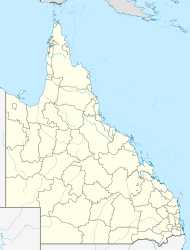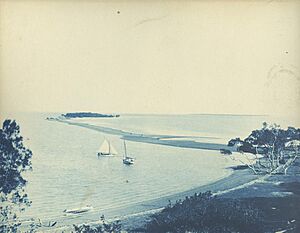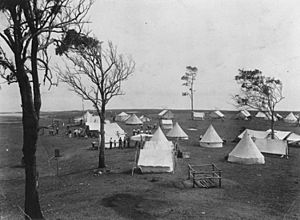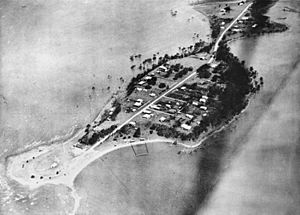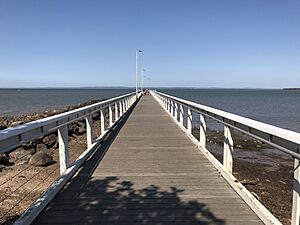Wellington Point, Queensland facts for kids
Quick facts for kids Wellington PointRedland City, Queensland |
|||||||||||||||
|---|---|---|---|---|---|---|---|---|---|---|---|---|---|---|---|
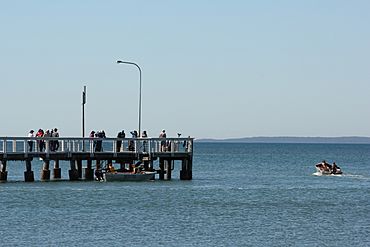
Wellington Point jetty
|
|||||||||||||||
| Population | 12,661 (2021 census) | ||||||||||||||
| • Density | 997/km2 (2,580/sq mi) | ||||||||||||||
| Postcode(s) | 4160 | ||||||||||||||
| Area | 12.7 km2 (4.9 sq mi) | ||||||||||||||
| Time zone | AEST (UTC+10:00) | ||||||||||||||
| Location |
|
||||||||||||||
| State electorate(s) | Oodgeroo | ||||||||||||||
| Federal Division(s) | Bowman | ||||||||||||||
|
|||||||||||||||
Wellington Point is a cool coastal town in Queensland, Australia. It's a popular spot by the sea near Brisbane, famous for a walk you can take across a sandbar to King Island when the tide is low. In 2021, about 12,661 people lived there.
Contents
Where is Wellington Point?
Wellington Point is about 25.5 kilometers (15.8 miles) east of Brisbane, the capital city of Queensland.
The town is surrounded by water on three sides. To the north and west is Moreton Bay. To the east and southeast is Hilliards Creek.
There are a few cool spots along the coast:
- Waterloo Bay is a part of Moreton Bay.
- Wellington Point is a piece of land that sticks out into the bay.
- King Island, also called Erobin, is a small island (about 2 hectares or 5 acres) north of Wellington Point.
The town gets its name from the Wellington Point headland. When the tide is low, you can walk from this headland all the way to King Island across a natural sandbar!
A Look Back: History of Wellington Point
Who Lived Here First?
Long before European settlers arrived, the Quandamooka people lived in the Redlands area, including Wellington Point. They were skilled at hunting, fishing, and gathering food. The Yuggera language group, specifically the Koobenpul tribe, lived along the coast from Redland Bay to the Brisbane River.
How Did Wellington Point Get Its Name?
In 1842, surveyors Robert Dixon and James Warner named the headland "Wellington Point." They named it after the Duke of Wellington. He was a famous leader of the British army who won the Battle of Waterloo in 1815. The bay next to Wellington Point was then named Waterloo Bay.
Early European Settlers
The first European settlers came to Wellington Point in the mid-1860s. This was after land was first sold in 1864. Important buyers included Thomas Lodge Murray-Prior and Captain Louis Hope. Captain Hope built Ormiston House and started a big sugar farm in nearby Ormiston.
Around 1869, Gilbert Burnett took over Captain Hope's sugar mill. He then bought land in Wellington Point to grow sugarcane and built his own sugar mill. In 1889, he built a two-story house called Fernbourne.
What Did People Do for Work?
In the early days, people worked in several industries. They grew sugar cane, cut timber, farmed fruits and vegetables, and fished. Today, fruit and vegetable farming still exists, but it's much smaller because more houses are being built.
The first Wellington Point Hotel was built around 1882. It was later taken down in 1972 and rebuilt as a modern hotel-motel.
Growing the Town
In 1887, Gilbert Burnett divided more of his land into smaller blocks, especially near the railway station. Streets like Edith, Alice, and Matilda were named after his daughters.
Wellington Point State School opened its doors on May 9, 1887. The Wellington Point Methodist Church opened on Easter Sunday, April 1, 1888. In April 1888, the headland area was set aside as a fun place for people to visit, called the Wellington Point Reserve.
Another house named Fernbourne was built in 1889. It was later renamed Whepstead Manor in 1900.
The Railway Arrives
The railway line from Brisbane, Queensland to Cleveland, Queensland was built through Wellington Point. It had two stations: Badgen (now gone) and Wellington Point railway station. The line opened on November 1, 1889. This made it easier for people to travel to Wellington Point and helped the area grow.
The railway line closed in 1960 because not many people were using it. But it reopened on July 26, 1986, bringing the Wellington Point railway station back to life.
By 1893, about 260 people lived in the area. Most worked in farming or services. By 1897, the very end of Wellington Point was officially made a recreation reserve.
The Point became more and more popular. In 1906, special "fruit trains" even ran to the area so people could try local strawberries and visit farms. By 1911, retired people and commuters started moving in, and more land was set aside for houses.
In 1924, Banyan fig trees were planted at the point. By 1925, the first small shop (kiosk) was set up. In 1927, Moreton Bay Fig trees were planted, which are now a famous part of the area.
Tough Times and New Developments
The late 1920s and 1930s were tough economic times for many people. However, this period also led to new jobs and building projects. For example, people started drilling for oil at the point in 1931. Electricity came to the area in 1931, and the Wellington Point Jetty was finished in 1937.
World War II Impact
World War II had a big effect on Wellington Point. From 1943 to 1944, the United States Navy set up an Anti-Aircraft Training School there. About 1500 US soldiers camped in the area. They practiced shooting and bombing, sometimes using King Island as a target.
After the War and Modern Growth
After the war, life became calmer, but changes were still happening. In 1959, new shops opened, including a chemist, doctor's surgery, butcher, garage, and fish shop. When running water became available in 1969, farmland started to be divided into blocks for new houses.
The Redland Cricketers Club opened in 1983. Wellington Point State High School opened on January 25, 1988. Redlands College, a private school, was also started on February 1, 1988.
Sadly, in 2012, the historic Fernbourne House was destroyed by fire. It was a two-story building from 1889, built by pioneer Gilbert Burnett.
More recently, in July 2020, Brisbane Airport opened a new runway. This has caused more planes to fly over Wellington Point, leading to some community concerns.
Who Lives in Wellington Point?
In 2011, Wellington Point had 11,787 people. Slightly more than half were female (50.9%), and 49.1% were male. The average age was 39 years old. Most people (73.1%) were born in Australia. Other common birthplaces included England (7.7%), New Zealand (5.1%), and South Africa (1.8%). Most people (90.8%) spoke only English at home.
By 2016, the population grew to 12,350 people. In 2021, it reached 12,661 people.
Important Historical Places
Wellington Point has a few places listed for their historical importance:
- 2A Main Road: This is the Wellington Point Reserve.
- 563 Main Road: This is Whepstead Manor.
What to See and Do
Some of the main attractions include the Point itself, King Island (which you can walk to at low tide), the Redlands Sporting Club, and Whepstead Manor (a historic house). There's also a shopping and restaurant area with the Wellington Point Clock Tower.
Schools in Wellington Point
Wellington Point State School
This is a government primary school for students from Prep to Year 6. It's located at 476 Main Road. In 2017, it had 546 students and a special education program.
Wellington Point State High School
This is a government secondary school for students from Year 7 to Year 12. It's located at 2-36 Badgen Road. In 2017, it had 914 students and also offers a special education program.
Redlands College
This is a private school for students from Prep to Year 12. It's located at 38 Anson Road. In 2017, it had 1,319 students.
Local Facilities
The Redland City Council has a mobile library service that visits Main Road.
The Wellington Point Jetty is a popular spot extending into Moreton Bay. There are also two boat ramps nearby for easy access to the bay. Another boat ramp is located at Bligh Street, leading into Hilliards Creek. All these facilities are managed by the Redland City Council.
There are many parks in Wellington Point for everyone to enjoy:
- Apex Park
- Ashley Court Park
- Brock Park
- Doug Tiller Reserve
- EGW Wood Sportsfield
- Geoff Skinner Wetlands Reserve
- Hilliards Creek Park
- Laurance Court Park
- Mcdonald Reserve
- Ormiston Manor Park
- Schonrock Street Park
- Tarradarrapin Wetlands
- Three Paddocks Park
- Wellington Point Reserve
- Whepstead Ave Park
Fun Attractions
Harry Atkinson Reef is a large (92 hectares or 227 acres) artificial reef in the Moreton Bay Marine Park. It's a great spot for marine life!
Getting Around: Public Transport
You can catch a train to Brisbane and other nearby towns from the Wellington Point railway station.


